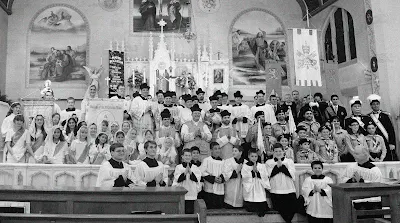 Images such as this recall the past, a long lost era of strong Mass attendance and thriving parishes from the pre-1950s. We sometimes encounter photographs like this, generally grainy and in sepia tones or black and white, when looking through old parish journals, or perhaps an elderly relative's picture album. We look back nostalgically at the beauty of the churches, filled with throngs of the faithful. We see the youthful optimism in the faces of the young and we envy the strong sense of Catholic identity. We see a vibrant church from days gone by in which there is a place for everyone, vocations are bountiful and there is an air of hope and certainty. We rue what we have lost, we scratch our heads and we ask ourselves, Why?
Images such as this recall the past, a long lost era of strong Mass attendance and thriving parishes from the pre-1950s. We sometimes encounter photographs like this, generally grainy and in sepia tones or black and white, when looking through old parish journals, or perhaps an elderly relative's picture album. We look back nostalgically at the beauty of the churches, filled with throngs of the faithful. We see the youthful optimism in the faces of the young and we envy the strong sense of Catholic identity. We see a vibrant church from days gone by in which there is a place for everyone, vocations are bountiful and there is an air of hope and certainty. We rue what we have lost, we scratch our heads and we ask ourselves, Why? Actually, this photo was taken two days ago in New Jersey: Mater Ecclesiae's Solemn High Mass of the Assumption took place at St Peter's Church, Merchantville, NJ. Fr. Robert C Pasley, KCHS, Rector of Mater Ecclesiae Roman Catholic Church, Berlin, NJ, who is also Chaplain to the CMAA, was the celebrant for their 13th Annual Assumption Mass. This photograph is witness to a thriving church and testament to the inspirational example being set here in the 21st century. Here it is in glorious colour:
The Annual Assumption High Choral Mass began thirteen years ago to thank and honour Our Lady for the establishment of Mater Ecclesiae and always features some of the greatest works of orchestral/choral music ever written for the Sacred Liturgy. This year the setting of the Ordinary of the Mass was "Mass No.1 in B-flat” by Johan Nepomuk Hummel. Other music included the motets "Venite Populi" by Mozart, “Ave Virgo Gloriosa” by Frescobaldi, “Assumpta est Maria” by Rathberger, and the “Concerto for two trumpets” along with the “Concerto for two oboes in D minor” by Vivaldi.
Music from past Masses includes: 2001 - “Missa in Angustiis (Lord Nelson Mass)” by F.J. Haydn, 2002 – “Messe Solennelle” by L. Vierne, 2003 - the “Missa Brevis in C (Orgelsolo-messe)” by Mozart, 2005 – “Missa Assumpta est Maria in Caelum” by Palestrina, 2006 – “Missa Dolorosa” by Caldara, 2007 – “Mass in B Flat” by F. Schubert, 2008 – “Missa della Capella (1641)” by C. Monteverdi, 2009 – “Missa Sancti Nicolai (1772)” by F.J. Haydn, 2010 – the “Missa Brevis” by Carl H Biber, 2011 – “Missa Papa Marcelli” by Palestrina, and in 2012 – the “Mass in E Minor” by A Bruckner.





















